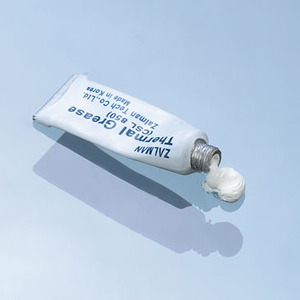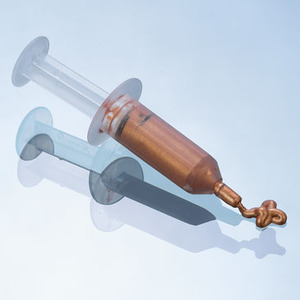
TIM particles
Enthusiasts generally rate gels and pastes above pads, but even here, there's a choice to be made: which substance do you want suspended in the goo?Mid-range enthusiast TIMs use micronised particles of ceramic substances, such as aluminium oxide, boron nitride or zinc oxide, all of which offer decent thermal conductivity and low electrical conductivity at a reasonable cost.
Meanwhile, more expensive TIMs incorporate particles of a metal with a high thermal conductivity, such as silver or copper.
However, these are more electrically conductive, so there's a danger of them causing problems if they leak from the interface area. On the one hand, optimal efficiency makes it worth the tiny risk, but on the other, we might only be talking a degree of difference.
Types of TIM
- Thermal grease: This is your basic, bog-standard TIM, and its thermal conductivity is usually less than 1W/mK.
- Basic thermal 'pad': The thermal conductivity of these pads can be up to 1.5W/mK. Strictly speaking, however, they haven't been 'pads' for some time, and have since been replaced by a form of thermal grease that's screen-printed onto the bottom of the heatsink.
- Ceramic thermal compound (such as Arctic Alumina): This is a solid ceramic thermal compound based on aluminium oxide and boron nitride. Its thermal conductivity will be around 4W/mK.
- Copper thermal compound (such as FrozenCPU Copper): This contains copper particles in a gel. Copper has the second-best thermal conductivity after silver, and TIM of this type will have a thermal conductivity of around 4.5W/mK.
- Silver thermal compound (such as Arctic Silver 5): This contains silver particles with particles of zinc oxide, boron nitride and aluminium oxide in a polysynthetic oil gel. Silver has the highest thermal conductivity of any metal, so these thermal compounds have a thermal conductivity of around 8W/mK.
- Liquid metal (such as CoolLaboratory Liquid Metal): This is an alloy that remains liquid at room temperature, so it can easily be brushed onto surfaces, and flows like a paste. This has high thermal conductivity, but it also has high electrical conductivity.
Advanced TIM
There are two additional types of TIM, one of which is available now, and another that's on its way. The first is phase-change metal, a solid metallic pad or paste that becomes a liquid at operating temperature. In many ways, these combine the benefits of thermal pads and greases or gels - they're easy to apply and have good thermal conductivity and spread, but are less susceptible to leakage or hardening.In the future, nanotechnology may also help out. Researchers at Purdue University in Indiana have already created a TIM based on carbon nanotubes, which create a Velcro-like mesh of fibres between two surfaces. These have the potential to conduct heat much more effectively than existing materials.

MSI MPG Velox 100R Chassis Review
October 14 2021 | 15:04













Want to comment? Please log in.